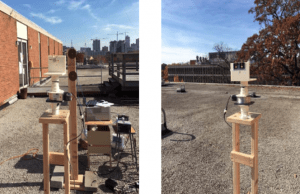M. Alhassoun, M. Varner, G.D. Durgin. “Theory and Design of a Retrodirective Rat-Race-Based RFID Tag“, IEEE Journal on RFID, vol 3, no 1, March 2019, pp 25-34.
Movement toward mm-wave backscatter communications in radio-frequency identification (RFID) systems necessitates seeking designs that compensate for the path loss introduced by the radio channel. A viable, simple, and power-efficient solution is to equip RFID tags with retrodirective arrays, which guarantee reflection with maximal gain in the direction of incidence. In this paper, we build upon a previous work to design and implement an original retrodirective tag in which its feeding network is a properly terminated rat-race coupler. We start by deriving the required terminations that ensure retrodirectivity. Then, we build a retrodirective tag and experimentally compare its radar cross section to that of a single-antenna tag. The measurements reveal that the radar cross section of the proposed retrodirective tag is, on average, approximately 6 dB more than that of a single-antenna tag while both tags have the same field-of-view. From the promising results in this paper, the proposed design is a potential candidate for next-generation microwave and mm-wave RFID tags because it is compatible with low-power reflection amplifiers (e.g., tunnel diodes), it can implement multiple modulation schemes without changing the circuit layout, and it can be implemented using only a single RF switch.
